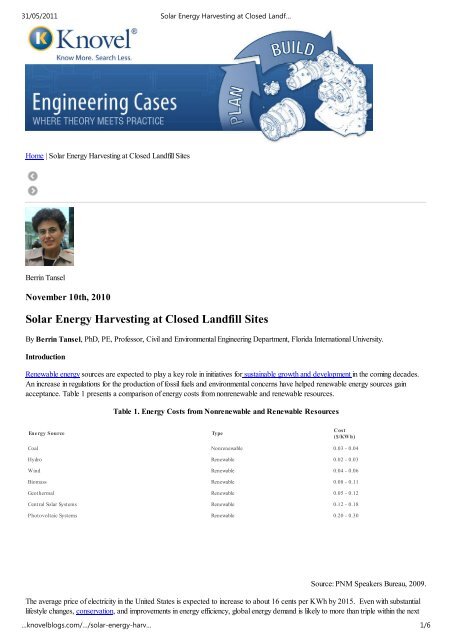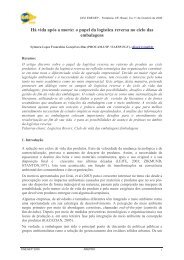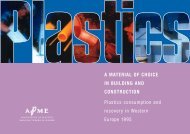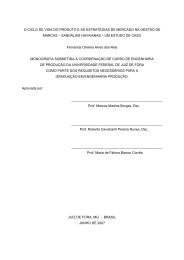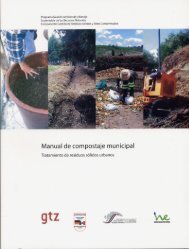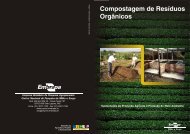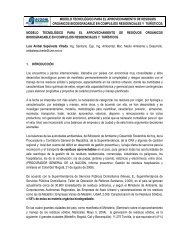Solar Energy Harvesting at Closed Landfill Sites | Engineering Cases
Solar Energy Harvesting at Closed Landfill Sites | Engineering Cases
Solar Energy Harvesting at Closed Landfill Sites | Engineering Cases
Create successful ePaper yourself
Turn your PDF publications into a flip-book with our unique Google optimized e-Paper software.
31/05/2011 <strong>Solar</strong> <strong>Energy</strong> <strong>Harvesting</strong> <strong>at</strong> <strong>Closed</strong> Landf…Home | <strong>Solar</strong> <strong>Energy</strong> <strong>Harvesting</strong> <strong>at</strong> <strong>Closed</strong> <strong>Landfill</strong> <strong>Sites</strong>Berrin TanselNovember 10th, 2010<strong>Solar</strong> <strong>Energy</strong> <strong>Harvesting</strong> <strong>at</strong> <strong>Closed</strong> <strong>Landfill</strong> <strong>Sites</strong>By Berrin Tansel, PhD, PE, Professor, Civil and Environmental <strong>Engineering</strong> Department, Florida Intern<strong>at</strong>ional University.IntroductionRenewable energy sources are expected to play a key role in initi<strong>at</strong>ives for sustainable growth and development in the coming decades.An increase in regul<strong>at</strong>ions for the production of fossil fuels and environmental concerns have helped renewable energy sources gainacceptance. Table 1 presents a comparison of energy costs from nonrenewable and renewable resources.Table 1. <strong>Energy</strong> Costs from Nonrenewable and Renewable Resources<strong>Energy</strong> SourceTypeCost($/KWh)Coal Nonrenewable 0.03 - 0.04Hydro Renewable 0.02 - 0.03Wind Renewable 0.04 - 0.06Biomass Renewable 0.08 - 0.11Geothermal Renewable 0.05 - 0.12Central <strong>Solar</strong> Systems Renewable 0.12 - 0.18Photovoltaic Systems Renewable 0.20 - 0.30Source: PNM Speakers Bureau, 2009.The average price of electricity in the United St<strong>at</strong>es is expected to increase to about 16 cents per KWh by 2015. Even with substantiallifestyle changes, conserv<strong>at</strong>ion, and improvements in energy efficiency, global energy demand is likely to more than triple within the next…knovelblogs.com/…/solar-energy-harv… 1/6
31/05/2011 <strong>Solar</strong> <strong>Energy</strong> <strong>Harvesting</strong> <strong>at</strong> <strong>Closed</strong> Landf…50 years. The two main types of systems used for harnessing solar energy are:1. <strong>Solar</strong> collectors with mirrored surfaces th<strong>at</strong> reflect sunlight to he<strong>at</strong> liquid, gener<strong>at</strong>ing electricity through steam power2. Photovoltaic (PV) cells th<strong>at</strong> absorb direct sunlightAlthough solar energy is free, harnessing solar energy requires investment. Some factors th<strong>at</strong> should be considered in the selection ofsolar harvesting systems include the following (Miggins, 2008):1. Type of solar harvesting system to be used for a specific applic<strong>at</strong>ion (mono, poly, amorphous, ribbon, concentr<strong>at</strong>ed, silicon- orcopper-based)2. <strong>Solar</strong> density (w<strong>at</strong>ts per square foot)3. Efficiency (conversion of light to energy)4. Durability (ability to withstand environmental factors)5. Physical properties of the surface and the solar system (he<strong>at</strong> tolerance, mounting, wiring, grounding, spacing requirements)6. Appearance, form and function, and dual-use deployment7. Manufacturer and availability, warranty, maintenance requirements, and useful life<strong>Closed</strong> landfill sites generally are developed as open areas and public parks, but some sites have been developed for active uses such assports complexes and shopping malls (Tansel, 1998). Recently, a number of closed landfills have been considered as potential sites forrenewable energy gener<strong>at</strong>ion (i.e., capturing energy from wind or sun). The city of Houston was awarded $50,000 from the U.S.Environmental Protection Agency (EPA) to develop a solar energy plant on a closed landfill to revitalize a 300-acre site near downtown(Barry and Tillman, 2008). Florida Power & Light (FPL) developed a solar energy project about half the size of a football field on aSarasota County landfill, fulfilling a promise to customers (Mayk, 2006). The New Jersey Meadowlands Commission (NJMC) isplanning to gener<strong>at</strong>e approxim<strong>at</strong>ely 5 megaw<strong>at</strong>ts of energy from solar harvesting on a landfill to produce renewable energy and encouragebusinesses to take advantage of the st<strong>at</strong>e’s growing green economy (Aberback, 2008). The Tessman Road <strong>Landfill</strong> in San Antonio,Texas, will be capped with a flexible solar energy–capturing cover consisting of more than 1,000 strips with photovoltaic silicon cells(Herrera, 2009). The placement of solar covers can reduce inspection and maintenance costs <strong>at</strong> the site while providing effective odorcontrol and storm w<strong>at</strong>er management.<strong>Landfill</strong> CharacteristicsThe design and oper<strong>at</strong>ional characteristics of a landfill th<strong>at</strong> may affect PV system install<strong>at</strong>ion and efficiency include the site area,topography, loc<strong>at</strong>ion, postclosure plans, cap system, and runoff control:Area: <strong>Closed</strong> sites are suitable to be developed as power parks if they have a large area with suitable orient<strong>at</strong>ion (i.e., southfacing).Topography: Evenness and symmetry in the landfill shape are important factors for the layout of a solar power–harvesting system.The shape of the landfill may affect the wind load and panel layout configur<strong>at</strong>ion. It is necessary to optimize the use of thetopography in rel<strong>at</strong>ion to wind load and panel layout for improved performance. The design and development of a site can beconfigured on the basis of the degree of comp<strong>at</strong>ibility of the finished site topography with solar energy–harvesting potential.Urban and rural loc<strong>at</strong>ion: Urban sites are closer to the power grid and the distribution system; hence, the losses duringdistribution are rel<strong>at</strong>ively small. Rural areas with high customer potential could be considered for solar systems. However, PVsystems can provide a sustainable altern<strong>at</strong>ive to help meet the increasing demands in urban areas.Postclosure plans: This project evalu<strong>at</strong>ed the postclosure use of well-maintained landfill sites. It is necessary to reevalu<strong>at</strong>e theimplement<strong>at</strong>ion of the postclosure care plan and maintenance needs <strong>at</strong> the candid<strong>at</strong>e sites for install<strong>at</strong>ion of the PV system forcomp<strong>at</strong>ibility of the existing infrastructure with the install<strong>at</strong>ion and maintenance requirements of the PV system.Geographical orient<strong>at</strong>ion: Site slopes and orient<strong>at</strong>ion are important because of the p<strong>at</strong>h of the sun during the day and sun/earthrot<strong>at</strong>ion during the year. The angles <strong>at</strong> which the surfaces receive sunlight are critical for the efficiency of a PV system. <strong>Sites</strong> withlarger areas facing south, fl<strong>at</strong> areas, and slopes between 0.2 m/m and 0.4 m/m are more suitable for install<strong>at</strong>ion of solar harvestingsystems.Cap system: In the solar energy interaction with the PV system, it was seen th<strong>at</strong> photovoltaic systems follow the most efficientangle by which the sun’s rays strike the solar panel. This angle is called the angle of incidence. A good angle of incidence producesmore energy. For this reason, solar panels have to be tilted to benefit from the best range of the solar incidence. The tilted panelsmust be mounted on found<strong>at</strong>ion systems th<strong>at</strong> can withstand wind loads while being comp<strong>at</strong>ible with the stability of the cap.Runoff control: Runoff management in landfills is achieved by infiltr<strong>at</strong>ion of w<strong>at</strong>er first through a veget<strong>at</strong>ive support layer and thenthrough a soil layer where the w<strong>at</strong>er is conveyed to surface w<strong>at</strong>er ditches and ponds. Placement of the solar panels on the landfillmay affect the runoff quantity and p<strong>at</strong>terns. Control and maintenance of the veget<strong>at</strong>ive cover must be evalu<strong>at</strong>ed so th<strong>at</strong> suitableveget<strong>at</strong>ive cover th<strong>at</strong> requires less maintenance can be utilized to minimize site access.<strong>Solar</strong> <strong>Energy</strong> Capture SystemsAlthough solar energy is a freely available renewable resource, its utiliz<strong>at</strong>ion to gener<strong>at</strong>e electricity involves either photovoltaic or solarthermal technologies.…knovelblogs.com/…/solar-energy-harv… 2/6
31/05/2011 <strong>Solar</strong> <strong>Energy</strong> <strong>Harvesting</strong> <strong>at</strong> <strong>Closed</strong> Landf…Photovoltaic technology: Photovoltaic technology utilizes solar panels consisting of solar cells constructed with semiconductingm<strong>at</strong>erials such as silicon. When sunlight hits the panel, a chemical reaction (a photovoltaic effect) takes place, resulting in electricitygener<strong>at</strong>ion. The gener<strong>at</strong>ed electricity then is collected through proper wiring systems (http://www.epa.gov/cleanenergy/energyand-you/affect/non-hydro.html#solar).Photovoltaic systems can be either fixed tilt or tracking. Each type requires a suitablefound<strong>at</strong>ion th<strong>at</strong> varies with the panel weight, wind loads, and other environmental factors.<strong>Solar</strong> thermal technology: <strong>Solar</strong> thermal systems collect solar energy through the use of mirrors or concentr<strong>at</strong>ors to he<strong>at</strong> a liquidand cre<strong>at</strong>e steam, which then is used to gener<strong>at</strong>e electricity (http://www.epa.gov/cleanenergy/energy-and-you/affect/nonhydro.html#solar).Low-temper<strong>at</strong>ure solar thermal systems (100oC/212oF) use various mirror configur<strong>at</strong>ions to concentr<strong>at</strong>e the sunlight and convert the energy into high-temper<strong>at</strong>ure he<strong>at</strong>and then to steam. Steam is used to gener<strong>at</strong>e electricity through the use of a turbine gener<strong>at</strong>or or by running chemical reactions.Placement of <strong>Solar</strong> <strong>Energy</strong> Systems on <strong>Closed</strong> <strong>Landfill</strong>sTable 2 summarizes the potential challenges and remedies <strong>at</strong> landfill sites for the install<strong>at</strong>ion of solar panels. For example, the TessmanRoad landfill employed flexible PV lamin<strong>at</strong>es side slopes (18 degrees) directly <strong>at</strong>tached to an exposed geomembrane cover. Combiningexposed geomembrane covers with lightweight panels (flexible PV strips) was a remedy for problems associ<strong>at</strong>ed with steep side slope. Inthe case of the Pennsauken landfill project in New Jersey, shallow precast concrete footings were used to provide a strong found<strong>at</strong>ion forthe PV system on the sloped surfaces, overcoming complic<strong>at</strong>ions of side slope install<strong>at</strong>ion. This facility used a ballast found<strong>at</strong>ion withcrystalline panels on top for maximum energy production. In general, solar panels are fixed to aluminum or steel frames by usingstanchions, and the frames are supported by concrete found<strong>at</strong>ions by ballasted frames, concrete slabs, or precast concrete footings.Among these altern<strong>at</strong>ives, concrete slabs are generally heavier than concrete footings and ballasted frames. They are also subject tocracks resulting from settlement and may be problem<strong>at</strong>ic on landfills because of concerns about settlement and side slope stability.Differential settlement may be a concern with array piers and footings. Ballast systems are the lightest and are preferred for fl<strong>at</strong> surfacesof landfills. Found<strong>at</strong>ion selection depends on factors such as the bearing capacity of the soil, landfill settlement, cap depth, and the weightof the PV system. Figure 1 shows the placement of solar panels on the top and side slopes of a landfill.Table 2. Potential Challenges and Remedies <strong>at</strong> <strong>Landfill</strong> <strong>Sites</strong> for Install<strong>at</strong>ion of <strong>Solar</strong> PanelsChallenge Impact Potential Remedy ExampleSteep slopesStorm w<strong>at</strong>erErosion intensityHigh wind loadsFound<strong>at</strong>ion stability for anchoring solarpanelsFlexible PV lamin<strong>at</strong>esOther lightweight solar systems with secure found<strong>at</strong>ionsRegradingUse of soil amendmentsTessman Road landfillPennsauken landfillCap system and finalcoverHigh maintenance needs of capNeed for regrading to increase thickness offinal coverIntegrity of cap systemLightweight, noninvasive found<strong>at</strong>ionsBallasted solar pl<strong>at</strong>forms and shallow footingsFort Carson army baseSettlementUneven surfaceStructural stress <strong>at</strong> settlement areasInfiltr<strong>at</strong>ion and w<strong>at</strong>er pondingFound<strong>at</strong>ion integrityIntegrity of gas systemIntegrity of leach<strong>at</strong>e pipingIntegrity of underground utilitiesFixed tilt mounting structuresLightweight shallow footings and ballastsPreclosure mitig<strong>at</strong>ionGeogrid reinforcementSelective placement loc<strong>at</strong>ions (i.e., older waste, construction, anddemolition waste)Pennsauken landfill, HolmesRoad landfillHigh wind and snow loadsSystem connectionsFound<strong>at</strong>ion stabilityMounting structures with high mechanical load r<strong>at</strong>ingsAvoidance of side slopesNACap and site maintenanceneedsSettlement surveysGas extraction activitiesErosion inspectionsVeget<strong>at</strong>ion managementPlacement of solar array around monitoring well headsPanel height to allow routine landscaping needsExisting permanent access roadsNAFigure 1. Placement of solar panels on top and sloped surfaces of landfill…knovelblogs.com/…/solar-energy-harv… 3/6
31/05/2011 <strong>Solar</strong> <strong>Energy</strong> <strong>Harvesting</strong> <strong>at</strong> <strong>Closed</strong> Landf…Power tower and linear concentr<strong>at</strong>ing solar power systems require large areas for optimal oper<strong>at</strong>ional capacity. Hence, they are bestsuited for large-scale production plants with a capacity of <strong>at</strong> least 50 megaw<strong>at</strong>ts (MW). Large-scale power production capability is alsorequired to optimize linear concentr<strong>at</strong>or and power tower solar systems. Among the available concentr<strong>at</strong>ing solar power systems,dish/engine systems can be used on landfills for smaller-scale production. Currently, PV solar systems have been the most commonlyused solar energy–harvesting systems th<strong>at</strong> have been implemented and tested on landfills. The technical feasibility of solar energyharvesting on landfills depends on comp<strong>at</strong>ibility of the PV systems with the existing landfill components. Important design and oper<strong>at</strong>ionalcomp<strong>at</strong>ibility consider<strong>at</strong>ions are described below.Wind and Snow LoadsWind loads increase the stress on the supporting structures by adding weight to the solar panels and components, resulting in failure of thesolar energy system. Accumul<strong>at</strong>ion of ice and snow imposes additional weight on the system, increasing the stress on the found<strong>at</strong>ion.Typically, panels in the crystalline and amorphous thin film cell c<strong>at</strong>egories are certified for wind speeds of 105 miles per hour (i.e.,mechanical loading of 50 pounds per square foot) (Sampson, 2009). Hence, for hurricane-prone regions such as Florida and regionsaffected by heavy snow, mounting systems certified to resist higher mechanical loadings must be considered. Some landfills requireregular top surface maintenance and the placement of mounting structures high enough to allow for site maintenance activities such asmowing grass. Taller systems are affected by increased weight and stress as a result of high wind loads and longer pier lengths andshould be supported by stronger found<strong>at</strong>ions (Sampson, 2009).Side Slope StabilityPlacement of panels on sloped surfaces (especially south-facing slopes <strong>at</strong> higher altitudes) can achieve maximum solar radi<strong>at</strong>ion(Sampson, 2009). Install<strong>at</strong>ion of panels on side slopes can be challenging in terms of ensuring good found<strong>at</strong>ion support, protection fromerosion, storm w<strong>at</strong>er control, shading, and settlement effects. Regular oper<strong>at</strong>ion and maintenance activities could increase the need forside slope repairs, resulting in additional costs. Remedial measures such as veget<strong>at</strong>ive surfaces and engineered retaining walls can reduceerosion effects (Sampson, 2009). For landfills with steep slopes, regrading and the use of additional topsoil can help achieve suitableslopes capable of supporting solar system placement (Sampson, 2009). In general, steep slopes require strong found<strong>at</strong>ions (pouredconcrete or precast concrete footings) with lightweight solar components. Hence, lightweight solar components of appropri<strong>at</strong>e mechanicalloading r<strong>at</strong>es with strong found<strong>at</strong>ions th<strong>at</strong> can resist wind loads and any additional load requirements produced by snow or ice arepreferred for sloped surfaces. It is also necessary to assess slope stability before starting construction activities to ensure the integrity ofthe cap and maintain adequ<strong>at</strong>e slope stability (Sampson, 2009).<strong>Landfill</strong> SettlementPhysicochemical, mechanical, and biochemical processes change the properties of disposed waste over time and cause settlement.<strong>Landfill</strong> settlement over time could result in the form<strong>at</strong>ion of surface cracks to the final cover; damage to the leach<strong>at</strong>e, gas collectionpiping, w<strong>at</strong>er drainage systems, and underground utilities; and form<strong>at</strong>ion of w<strong>at</strong>er-holding depressions (Sampson, 2009).Shading EffectsMaximum energy gener<strong>at</strong>ion from solar energy harvesting systems can be achieved by minimizing the shading of the panels. <strong>Solar</strong> systemarrays should be placed with adequ<strong>at</strong>e spacing so th<strong>at</strong> they do not shade one another and to balance the placement of systemcomponents (inverters, wiring, and combiner boxes). For instance, the Holmes Road landfill adopted a layout of 15 acres/MW to avoidshading effects and allow for the necessary balance of system components (SRA, 2008).<strong>Solar</strong> System Weight and Found<strong>at</strong>ion Consider<strong>at</strong>ionsThe weight of the solar panels and mounting structures selected for a project is of gre<strong>at</strong> significance in deciding which solar harvesting…knovelblogs.com/…/solar-energy-harv… 4/6
31/05/2011 <strong>Solar</strong> <strong>Energy</strong> <strong>Harvesting</strong> <strong>at</strong> <strong>Closed</strong> Landf…system to install on a landfill cap. Monocrystalline, polycrystalline, and amorphous thin film cells are available with varying weights,efficiency levels, and costs. Mounting and found<strong>at</strong>ion structures supporting the solar panels vary depending on the weight of the panels,additional loads resulting from wind or snow or ice, side slope stability, and settlement effects. Both monocrystalline and polycrystallinepanels (rigid panels) require rigid frame mountings to prevent cracking (Sampson, 2009). Because of the output advantage of the rigidpanels over thin film panels, rigid panels are preferred when there is limited space. Amorphous thin film cells (flexible panels) aregenerally lighter and lower in cost but have lower efficiency for power production per unit area. These panels are preferred when weightis a concern or there is a need to provide a strong found<strong>at</strong>ion because of side slope conditions. Amorphous thin film cells (i.e., Uni<strong>Solar</strong>model PVL flexible lamin<strong>at</strong>e amorphous thin film cells) have been used on sloped surfaces by <strong>at</strong>taching the PV strips directly to thegeomembrane of the landfill cap. Since PV strips are capable of producing high output per unit weight and do not require mountingstructures or found<strong>at</strong>ions, they were used successfully on slope surfaces (18 degrees) <strong>at</strong> the Tessman Road landfill and reduced sideslope erosion. Tracking systems weigh more than fixed systems as a result of their increased need for mounting structures andfound<strong>at</strong>ions. Tracking systems require found<strong>at</strong>ions with deeper piers and footings, sometimes supported by precast concrete footings.Deeper piers, if used as found<strong>at</strong>ion support, could increase the weight on the landfill, increase settlement, or subject the install<strong>at</strong>ion toproblems with side slope stability (Sampson, 2009). The landfill cap depth needed to support the PV system depends on the deadweightloads contributed by the piers and footings (SRA, 2008). Selection of a suitable PV system depends on the weight of the system(tracking systems are heavier than fixed tilt systems), the type of waste and its properties, and side slope stability (Sampson, 2009). Ingeneral, fl<strong>at</strong> surfaces have fewer found<strong>at</strong>ion requirements than sloped surfaces and are the preferred loc<strong>at</strong>ions for installing heavycrystalline silicon solar cells with suitable found<strong>at</strong>ions (i.e., ballast systems) for maximum energy production. For sloped surfaces, lighterpanels with strong found<strong>at</strong>ions should be considered (precast or poured concrete footings) and generally are preferred (Sampson, 2009).Maintaining the Integrity of the Cap SystemClearing, filling, grading, and compaction activities generally are performed during the development of a landfill for PV system install<strong>at</strong>ion.During install<strong>at</strong>ion of solar panels, extreme care must be taken to avoid damaging the landfill cap or exposing the waste. If the site isheavily veget<strong>at</strong>ed, thinning of veget<strong>at</strong>ion may be necessary (Sampson, 2009). Install<strong>at</strong>ion of solar systems on landfills requires goodfound<strong>at</strong>ions for system placement, which depends on landfill cap characteristics to support the footings. Generally, during the planningstage, it is necessary to consider the cap design and the anticip<strong>at</strong>ed loads by the PV system and its components. For most cases,prefabric<strong>at</strong>ed concrete piers or concrete slabs should be sufficient to support a solar system. Existing or future landfill gas-to-energyrecovery infrastructure also should be considered (Sampson, 2009). An adequ<strong>at</strong>e soil layer should exist for trenching activities (aminimum of 14 inches of soil is required to trench for electrical line placement) with no or minimal impact on clay or geosynthetic liner(Messics, 2009; Sampson, 2009). If the landfill requires regular top surface (cap) maintenance (e.g., mowing of grass), placement ofstructures high enough for the oper<strong>at</strong>ion of mowing equipment bene<strong>at</strong>h the structures should be considered. Using short grasses forveget<strong>at</strong>ion may be preferred to decrease the mowing activities and avoid disturbance to the panels.Environmental SuitabilityIn the United St<strong>at</strong>es, a fl<strong>at</strong> or south-facing slope is optimal for solar energy capture. The solar capture depends on the l<strong>at</strong>itudinal loc<strong>at</strong>ionof the site. Placement of panels on sloped surfaces (especially south-facing slopes <strong>at</strong> higher altitudes) can achieve maximum solarradi<strong>at</strong>ion and benefit the project. However, it is necessary to provide a strong found<strong>at</strong>ion, account for erosion and storm w<strong>at</strong>er control,and minimize shading effects (Sampson, 2009). Side slopes of 3:1 (18-degree slope) are preferred in landfills. Slopes gre<strong>at</strong>er than 5degrees are affected by erosion effects, shading, and storm w<strong>at</strong>er, which have to be considered in solar system install<strong>at</strong>ion. Engineeredretaining walls or veget<strong>at</strong>ive surfaces can improve slope stability, and additional soil may be required to improve slope characteristics.Because of slope stability limit<strong>at</strong>ions, lightweight panels with strong found<strong>at</strong>ions (poured or precast concrete footings) generally arerecommended.Environmental consider<strong>at</strong>ions for developing closed landfills as power parks include reducing greenhouse emissions, encouragingenvironmental sustainability, bettering the aesthetics of the site, and adding a renewable energy system for power production. One of themost important aspects of the use of solar systems is the reduction of greenhouse emissions. For each KWh of solar energy installed inthe United St<strong>at</strong>es, about 7.18 × 10 -4 metric tons of CO 2 are avoided.ReferencesAberback, B. NJMC to Gener<strong>at</strong>e <strong>Solar</strong> Power on <strong>Landfill</strong>. NJMC news release, October 2, 2008.Barry, D., and Tilman, T. Houston Awarded $50,000 from EPA for <strong>Solar</strong> Project. U.S. EPA, news release, July 29, 2008.Herrera, T. <strong>Solar</strong> Power <strong>Landfill</strong> Cover Goes Live in Texas. greenbiz.com news release, April 6, 2009.Mayk, L. FPL Has Sunny Spot for <strong>Solar</strong> Panel Project. Herald Tribune, Sarasota, FL, March 18, 2006.Messics, M. Case Study: Pennsauken <strong>Landfill</strong> <strong>Solar</strong> Project. Presented <strong>at</strong> Renewable <strong>Energy</strong> <strong>at</strong> <strong>Closed</strong> <strong>Landfill</strong> Workshop, Mansfield,MA, June 17, 2009.…knovelblogs.com/…/solar-energy-harv… 5/6
31/05/2011 <strong>Solar</strong> <strong>Energy</strong> <strong>Harvesting</strong> <strong>at</strong> <strong>Closed</strong> Landf…Miggins, J. <strong>Harvesting</strong> <strong>Solar</strong> <strong>Energy</strong> Overview of Systems: Options and Benefits of <strong>Solar</strong> <strong>Energy</strong> Systems. Seminar present<strong>at</strong>ion, 2008.http://files.harc.edu/Projects/Cultiv<strong>at</strong>eGreen/Events/20070212/HowHarvest<strong>Solar</strong><strong>Energy</strong>.pdf.PNM Speakers Bureau. Customer <strong>Solar</strong> <strong>Energy</strong> Program Brochure, 2009.Sampson, G. <strong>Solar</strong> Power Install<strong>at</strong>ions on <strong>Closed</strong> <strong>Landfill</strong>s: Technical and Regul<strong>at</strong>ory Consider<strong>at</strong>ions. Prepared for U.S. EnvironmentalProtection Agency, Office of Solid Waste and Emergency Response, Office of Superfund Remedi<strong>at</strong>ion and Technology Innov<strong>at</strong>ionWashington, D.C., September, 2009. http://www.clu-in.org/download/studentpapers/<strong>Solar</strong>-Power-Install<strong>at</strong>ions-on-<strong>Closed</strong>-<strong>Landfill</strong>s-Sampson.pdf.SRA Intern<strong>at</strong>ional. <strong>Solar</strong> Power Analysis and Design Specific<strong>at</strong>ions: TechnicalAssistance to the City of Houston, 2008. http://www.epa.gov/brownfields/sustain_plts/factsheets/houston_solar.pdf.Tansel, B. Land Use and Development Experiences with <strong>Closed</strong> <strong>Landfill</strong>s. Journal of Solid Waste Management and Technology, vol. 25,no. 3–4, pp. 181–188, 1998.Share and Enjoy:One Response to “<strong>Solar</strong> <strong>Energy</strong> <strong>Harvesting</strong> <strong>at</strong> <strong>Closed</strong> <strong>Landfill</strong> <strong>Sites</strong>”1. ecd.fan Says:March 9th, 2011 <strong>at</strong> 2:54 amThose industry-leading light-weight thin-film solar lamin<strong>at</strong>e panels used in both the Tessman Road landfill project in San Antonio aswell as here in the Hickory Ridge project in Atlanta are made by Uni-<strong>Solar</strong> Ovonics, a subsidiary of the Michigan company<strong>Energy</strong> Conversion Devices [ticker symbol ENER].The E.P.A estim<strong>at</strong>es there are approxim<strong>at</strong>ely 100,000 closed landfills {ideally suited for similar solar lamin<strong>at</strong>e panel projects}.The story as aired on FoxNews… http://www.youtube.com/w<strong>at</strong>ch?v=sXkTLKhGLY0Uni-<strong>Solar</strong>’s website: http://www.uni-solar.com/products/Leave a ReplyName (required)Mail (will not be published) (required)WebsiteSubmit CommentCompanySolutionCustomersPartnersNewslettersSubscriptions© 2011 Knovel Corpor<strong>at</strong>ion. All Rights Reserved.…knovelblogs.com/…/solar-energy-harv… 6/6


